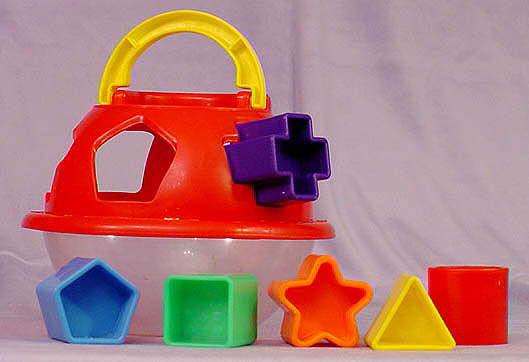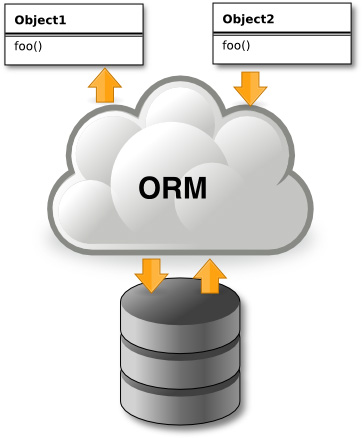CSC/ECE 517 Fall 2009/wiki3 12 obj to relational
Patterns for mapping objects to relational databases
The Object-Relational Mismatch

Object-orientation and relational model are different paradigms of programming.[1] The object paradigm is based on building applications out of objects that have both data and behavior, whereas the relational paradigm is based on storing data. With the object paradigm, one traverses objects via their relationships whereas with the relational paradigm one duplicates data to join the rows in tables.[2] The difference between how object models work and relational databases is known as the “Object-Relational Impedance Mismatch”. This is just nerd-speak for “they are different”. In analogy, we could consider the example of the ball and shape game. It's the same thing; you can’t fit a square in a triangle hole.[10]
One way to avoid the impedance mismatch between objects and relations is to use an object-oriented database. However, systems often need to store objects in a relational database. Sometimes a system needs relational calculus or the maturity of a relational database. Other times the corporate policy is to use a relational database rather than an object-oriented database. Whatever the reason, a system that stores objects in a relational database needs to provide a design that reduces the impedance mismatch.[5] One of the secrets of success for mapping objects to relational databases is to understand both paradigms, and their differences, and then make intelligent trade offs based on that knowledge.[2] An application that maps between the two paradigms needs to be designed with respect to performance, maintainability and cost to name just a few requirements.[4]
Persistence frameworks were designed to reduce the amount of work needed to develop an object-oriented system that stores data in a relational database. For this reason, this framework area is often also referred to as object-relational mapping or ORM (see the below Figure). The goal of a persistence framework is to automatically map objects to and from a database seamlessly so that information can be quickly and easily retrieved in object format, and then subsequently stored in its relational structure. This aids in system development and maintenance greatly. The mundane details of writing one's own create, read, update, and delete functions are taken care of, so one can concentrate on designing and building the application.[11]
Patterns
This page describes patterns for mapping objects to relations.
Persistence Layer
Motivation: If one builds a large object-oriented business system that stores objects in a relational database, one can spend a lot of time dealing with the problems of making one's objects persistent. Also, every programmer working on the system has to know SQL and the code can become tied to the database. It can be a lot of work to convert the system from using Microsoft Access to using DB2, or even adding a few variables to an object. One needs to separate one's domain knowledge from knowledge of how objects are stored in a database to protect developers from these types of changes. The problem is how to save objects in a non object-oriented storage mechanism such as a relational database with the developers not having to know the exact implementation.
Solution: The solution is to provide a Persistence Layer that can populate objects from a data storage source and save their data back to the data storage source. This layer should hide the developer from the details of storing objects. All persistent objects use the standard interface of the Persistence Layer. If the data storage mechanism changes, only the Persistence Layer needs to be changed. For example, the corporate direction may be to start using Oracle rather than DB2 and then switch in midstream. The system needs to know how to store each object and to load it. Sometimes an object is stored in multiple databases over multiple media. An object that is part of a more complex object needs to keep track of which object it is a part; this is called the owning object. This owning object idea makes it easier to write complex queries. Therefore it is important for the Persistence Layer to provide a means to uniquely identify each object and its parent.
Example Implementation:
There has been a lot of work done towards describing the details of building Brokers [BMRSS 96]
correctly. Because of this and because we have more experience with implementing a Layered Object, our
examples will focus around this implementation of the pattern. The other patterns described do work in the
Broker implementation and we will mention briefly how this can be done in our discussions of the other
patterns. However, all of our example code will describe the implementation as it relates to the
PersistentObject.
Figure 1 is a UML class diagram for an implementation of Persistent Layer which map domain objects to a
relational database. Note that in this example, domain objects that need to be persisted are subclasses of
the PersistentObject. The PersistentObject provides for the interface to the Persistence
Layer. The PersistentObject interacts with the Table Manager, which will provide the physical table
name for the SQL Code. During the SQL Code generation, the PersistentObject interacts with the
Connection Manger to provide the necessary database connection. If needed, the OID Manager is queried
for a new unique identifier. Thus, the PersistentObject is the central hub for any information the
domain object requires but does not contain in the instance. The PersistentObject provides the
standard interface to the Persistence Layer. Once the SQL Code has been prepared with the cooperation of
the other patterns, the SQL statement is “fired” by the Database Components. In IBM’s VisualAge for
Smalltalk these are the AbtDBM* applications.
The attributes for the PersistentObject are as follows:
· objectIdentifier – This is a unique identifier for the object and can be the database key.
· isChanged – Identifies whether or not the object “isDirty” which tells the Persistence Layer
to write the change to the database.
· isPersisted – Identifies whether or not the object has ever been written to the database.
· owningObject – Identifies the parent object (in a complex object) and is used as a foreign key
in the database. Note that the foreign key is stored with the object not the parent object.
The public methods for the PersistentObject are as follows:
· save – Writes the object data to the database. It will update or insert rows as necessary.
· delete – Deletes an object data from the database.
· load: - Returns a single instance of a class with data from the database.
· loadAll – Returns a collection of instances of a class with all the data from the database for
that particular class. This is useful for retrieving data for selection lists.
· loadAllLike: - Returns a collection of instances of a class will select data from the database.
Conclusion
The concurrency patterns discussed above involve coordinating concurrent operations. They address two types of problems:[5]
Shared resources - When concurrent operations access the same data or another type of shared resource, operations may interfere with each other if they access the resource at the same time. To ensure that operations on shared resources execute correctly, the operations must be sufficiently constrained to access their shared resource one at a time. However, if the operations are overly constrained, then they may deadlock and not be able to finish executing.
Sequence of operations - If operations are constrained to access a shared resource one at a time, it may be necessary to ensure that they access the shared resource in a particular order. For example, an object cannot be removed from a data structure before it is added to the data structure.
See Also
- Monitor Object
- Active Object
- Thread pool pattern
- Reactor patter
- Double Buffering
- Scheduler
- Asynchronous Processing
References
[1] Wolfgang Keller, Mapping Objects to Tables - A Pattern Language http://www.objectarchitects.de/ObjectArchitects/papers/Published/ZippedPapers/mappings04.pdf
[2] Scott W. Ambler, President, Ronin International, Mapping Objects To Relational Databases http://www.crionics.com/products/opensource/faq/docs/mappingObjects.pdf
[3] Scott W. Ambler, Mapping Objects to Relational Databases: O/R Mapping In Detail http://www.agiledata.org/essays/mappingObjects.html
[4] Wolfgang Keller, Object/Relational Access Layers - A Roadmap, Missing Links and More Patterns http://citeseer.ist.psu.edu/4328.html
[5] Joseph W. Yoder, Ralph E. Johnson, Quince D. Wilson, Connecting Business Objects to Relational Databases http://citeseerx.ist.psu.edu/viewdoc/download?doi=10.1.1.34.7703&rep=rep1&type=pdf
[6] Michael R. Blaha, William J. Premerlani and James E. Rumbaugh, Relational Database Design using an Object-Oriented Methodology http://www.sims.monash.edu.au/subjects/ims2501/seminars/oomodelling.pdf
[7] http://www.cetus-links.org/oo_db_systems_3.html
[8] http://www.ibm.com/developerworks/library/ws-mapping-to-rdb/
[10] http://cantgrokwontgrok.blogspot.com/2009/03/tech-day-1-nhibernate.html
[11] http://www.adobe.com/newsletters/edge/october2008/articles/article2/index.html?trackingid=DWZST
